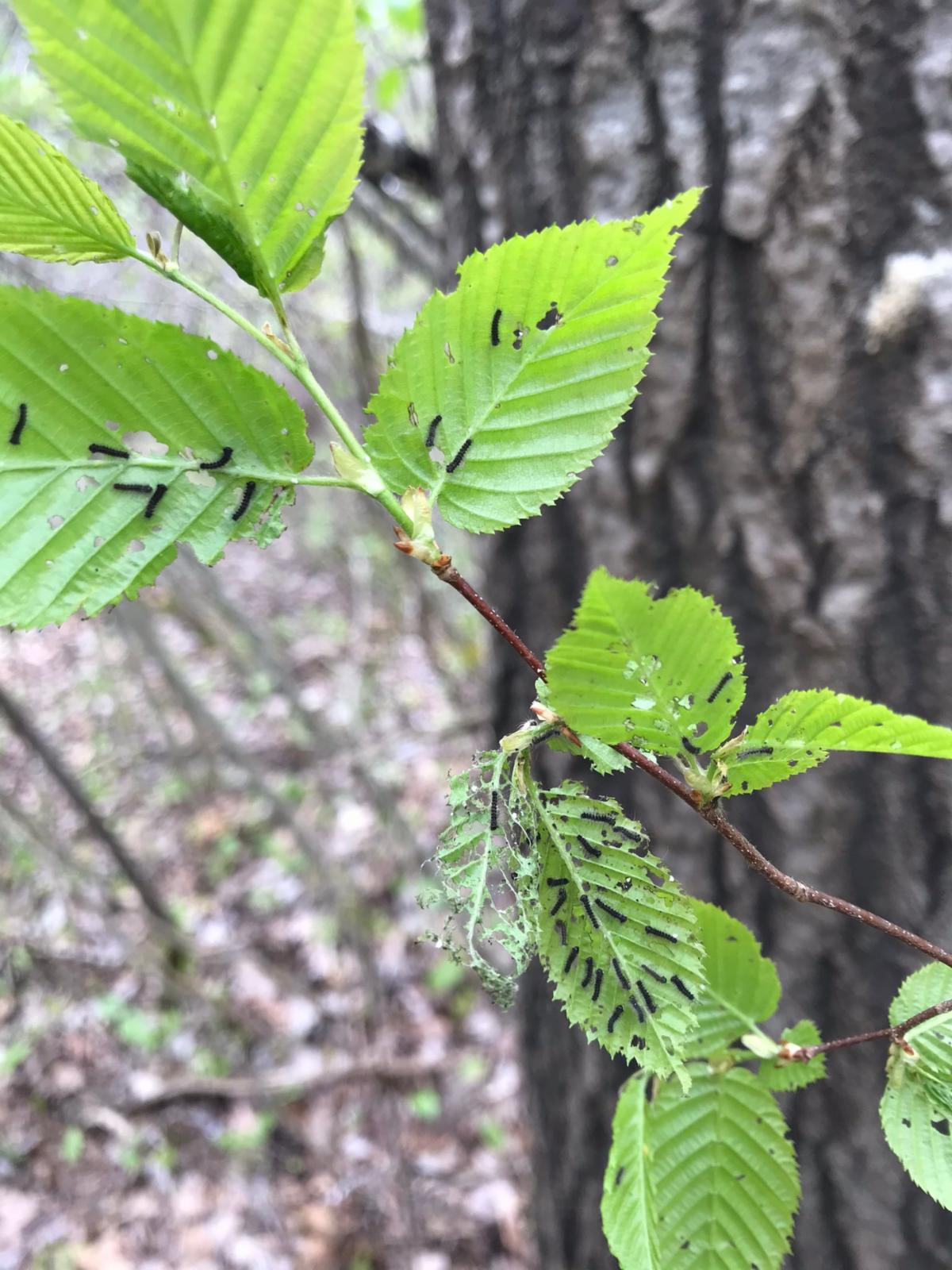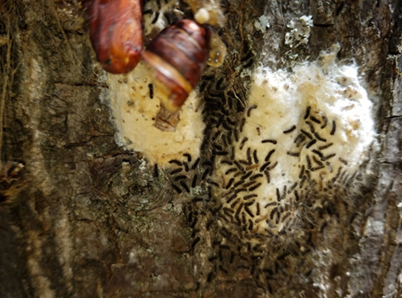Spongy Moth
Spongy Moth - Information about this Non-Native Invasive Insect
Overview of the Forest Sustainability Program - Spongy Moth
 | The Bay County Forest Sustainability Program (formerly known as Gypsy Moth) was established in 1989 to control outbreak levels of the invasive species Lymantria dispar, the Spongy Moth (formerly known as the Gypsy Moth), that were beginning to cause damage to area trees. Heavy infestations of the Spongy Moth cause area wide damage to trees, woodlots and adjacent property when the caterpillar life stage eats the leaves off of area trees (defoliation). Spongy Moths prefer to feed on oak, poplar, birch, willow, apple, and even spruce and pine. These are the dominant trees types in our landscape and woodlots. Defoliation makes the trees susceptible to disease and even death. In March of 2023, the Gypsy Moth Suppression Program changed their name to the Forest Sustainability Program due to the official name change of the Spongy Moth. The Forest Sustainability Program serves to protect trees in Bay County from defoliation and damage from Spongy Moth caterpillars by controlling Spongy Moth populations before they reach outbreak levels. |
AERIAL SPONGY MOTH TREATMENT IN BAY COUNTY WILL TAKE PLACE MAY 16TH, 2024
 | The Bay County Forest Sustainability Program monitors for and works to suppress Spongy Moths and other non-native pests that affect trees and plants in Bay County. In an effort to protect trees from feeding Spongy Moth caterpillars and treatment was scheduled for Bay County in locations where Spongy Moth populations have reached outbreak levels. Treatment will take place On May 16th, weather permitting. Treatment will occur between 7 am to 12 pm (noon). On the day of treatment, weather parameters for spraying needed to be light winds (3-10 miles per hour), humidity above 50% and less than 40% chance of rain predicted for the next four to six hours. Weather conditions were within these parameters. If treatment must be cancelled due to weather, treatment will take place within the few days after the set treatment date. |
| The 3 wooded spray block area made up of 835 acres will be treated in the spring of 2024. When the aerial treatment occurs, Bay County residents may notice a low-flying, yellow fixed-wing aircraft over wooded areas between 7:00 a.m. to 12:00 p.m. on the day of the treatment operations. |  |
 | The aircraft was spraying Foray 48B, a naturally-occurring forest health product that contains the soil bacterium Bacillus thuringiensis kurstaki (Btk) that specifically affects Spongy Moths caterpillars that are feeding at the time of treatment. BT has no known impact to non-target organisms such as humans, pets, birds, fish, and other insects. Field monitoring is performed afterwards to ensure that there are no adverse impacts. The product is an OMRI Certified organic, water-based, liquid formulation of BT that is applied to the forest canopy at a rate of ½ gallon per acre. The active ingredient is Bacillus thuringiensis variety Kurstaki (Btk). Btk will only affect the Spongy Moth Caterpillars that will be feeding in the tree canopies at the time of application. |
The Forest Sustainability Program has implemented a Pandemic Preparedness Plan which includes extra sanitation procedures and social distancing expectations in order to protect the health and safety of staff and the public during this treatment activity. For more information contact Program Coordinator Jeremy Lowell at (989-895-4195). The Bay County Forest Sustainability Program is a division of the Bay County Environmental Affairs and Community Development Department.
The following are the insecticide and method of application:
- Biological Insecticide Common Name: Foray 48B, this product is OMRI certified organic so it can be used on organic foods. Active Ingredient in the insecticide: Bacillus thuringiensis kurstaki (Btk)
- Method of Application: Aerial application by a yellow fixed-wing airplane flying low over forested areas.
2024 Bay County Spongy Moth Aerial Treatment
Notification: Upcoming Spongy Moth Aerial Spray Treatment
The Bay County Forest Sustainability Program is finalizing preparations for 2024 aerial treatment of 3 wooded areas making up 835 acres in Bay County where Spongy Moth populations have reached outbreak levels. The treatment areas are located in Mount Forest Township.
Treatment is tentatively scheduled to be completed in one day in the month of May, weather permitting. Spray operations will be done between 7:00 a.m. and 12:00 p.m. (noon). Treatment will take up to a few hours to complete. Al’s Aerial Spraying from Ovid, Michigan will provide a yellow fixed-wing airplane to spray infested woodlots and the airplane will fly about 50 feet over the treetops while spraying.
For more information on the Forest Sustainability Program, please go to our webpage at https://www.baycountymi.gov/ForestSustainability or contact Jeremy Lowell, Forest Sustainability Coordinator at [email protected] or by calling 989-895-4235.
Landowner Authorization Forms
The Forest Sustainability Program staff sent out letters to landowners that have wood lots and wooded areas with the best sites to successfully monitor the Spongy Moth populations in Bay County. To conduct routine yearly monitoring, staff needs the cooperation of landowners like you. Letters were sent out to landowners describing how and when Spongy Moth monitoring is conducted, along with a Landowner Authorization for Spongy Moth Monitoring Form to fill out and send back to our department. The Landowner Authorization for Spongy Moth Monitoring Form allows staff to conduct monitoring on your property in order to monitor and treat the invasive non-native Spongy Moth. Staff will provide homeowners with field report updates on what they find in your area. By providing your e-mail address staff can provide you with the field report updates electronically. If you have any questions regarding this program, other invasive species, or any tree health concerns please contact Jeremy Lowell, Forest Sustainability Program Coordinator at 989-895-4195 or at [email protected]. None of your contact information will be shared outside of our office.
The 2023 Spongy Moth Egg Mass Fall/Winter Monitoring is Competed!
| The Forest Sustainability Program completed the fall and winter Spongy Moth egg mass monitoring in December 2023. This monitoring helps determine what locations will require spring treatment in 2024. Spongy Moth monitoring done throughout this past spring and summer have shown that there are a few areas in Bay County where Spongy Moth populations are still on the rise. Areas with more than 300 egg masses per acre we scheduled for treatment in spring of 2024 where allowed. |  |
| | |
Services Offered by the Forest Sustainability Program
To help protect the health of trees in Bay County, the Forest Sustainability Program provides the following services:
-
Surveillance Monitoring: Conduct surveillance monitoring in wooded areas to evaluate the prevalence and density of Spongy Moth at its various life stages to determine if they are reaching outbreak level that can damage area trees. All wooded and residential areas of Bay County are monitored. When monitoring shows populations are at significant outbreak levels, treatment is provided to reduce the population and control the infestation. This includes determining where out-break level populations occur, contracting with an aerial applicator, and evaluation of treatment results.
-
Public Education: Staff also provides education to the public on what to look for and best tree care practices to maintain healthy trees that can withstand attach by Spongy Moths and other invasive species that could damage our trees. Staff presents educational programs for schools, property owners, and local civic groups, which include information on the life cycle of the Spongy Moth, how it fits into our local ecology, and best management practices to control Spongy Moths.
-
Treatment to Suppress Spongy Moth: Staff conduct treatment to help with the suppression of Spongy Moth. All treatments are compliant with National Pollution Discharge Elimination System (NPDES) permit requirements and Michigan Department of Agriculture and Rural Development’s (MDARD) Regulations 636 and 637 for the use of pesticides. Continue to follow guidelines and management practices outlined by USDA Forest Service and MDARD.

Click on the link above for answers to some of the Frequently Asked Questions about Spongy Moth
Spongy Moth Caterpillar Hatch Video
Baby Spongy Moth Caterpillars are freshly hatched and ready to start eating the leaves off local trees.
